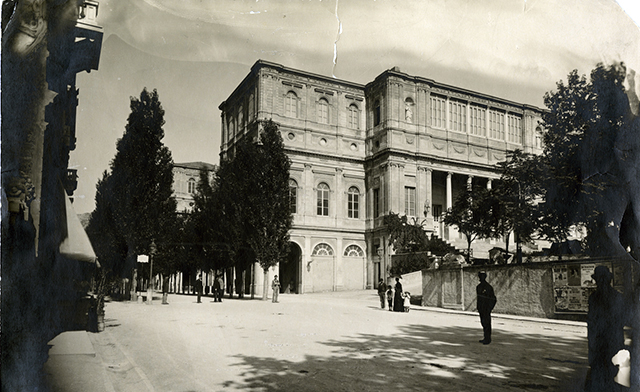
Fulvio Tomizza
Tomizza is the Voice of Istria. Thanks to his writings, the tragedy of this little peninsula in the heart of Europe has become known to an international readership. For centuries this territory was contested, divided and partitioned among three different peoples and nations. The experience of being uprooted and forced to leave his native earth in the postwar period, together with tens of thousands of his countrymen, forms the grievous and still painful core of his novels. Fulvio Tomizza was 20 years old when he chose exile, arriving in Trieste after many difficulties, in 1955.
Born in Materada (Umago) in 1935, as a child he experienced Fascism and the War and completed his schooling in a Capodistria occupied by Yugoslavia. Attracted by socialist ideals, unlike the rest of his family he initially decided to remain and live in the communist system. But as a university student in Belgrade and Ljubljana he witnessed the failure of this system firsthand.
The most dramatic moment during this period was the death of his father, whose body and spirit had been broken by political persecution. This event might have radicalised a youth of his intelligence and sensitivity. Instead, Tomizza, who was intimately tied to his native earth and its people, chose the difficult path of analysis, and of the knowledge that leads to an understanding of those different from ourselves.
Living in exile in Trieste, he decided to become a writer. While working as a journalist for Radio Trieste (today the RAI), he published his first novel, Materada, in 1960. The novel was well received by the leading Italian critics. Other successes followed: The Girl from Petrovia and The Acacia Wood. All three novels were later published together as The Istrian Trilogy.
Tomizza would set several novels in Trieste, a city which had become his home, not only because of the many years he had lived here, but because this was where he had matured as a man and a writer. The Trieste novels are: Miriam’s City, Where to Turn, Tree of Dreams, Friendship, The Newlyweds in via Rossetti, Franziska, Guilty Relations, and the posthumous The Visitor. His original style and sensibility gained him an evergrowing recognition and appreciation among readers and critics
alike. His novel, The Best Life, won the Strega Prize in 1977, and was translated into 10 languages.
Over the next two decades, his production was enriched by a cycle of historical novels. The most representative of these is Evil Comes from the North (1984), based on the figure of the Bishop of Capodistria, Pier Paolo Vergerio, who left the Church of Rome and converted to Protestantism.
His final battle with a protracted illness did not stop his work as a writer, and he continued to produce both novels and short essays and reflections on contemporary life (A Rearview of Trieste). Tomizza died in Trieste on 21 May 1999, and is buried in Materada. The Visitor (1999), The House with the Almond Tree (2000), Dalmatia Dream (2001), The Adriatic and Other Routes (2007) and My Literary Summers (2009) appeared posthumously.
The Trieste of Tomizza
Download “The Trieste of Tomizza” Map [.pdf ]
 |
 |
 |
 |
1. Public Garden
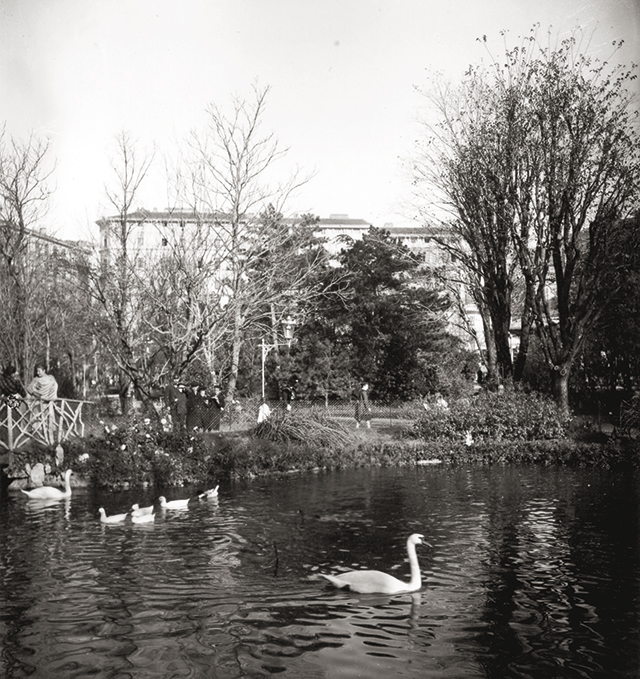
The Public Garden, laid out in 1854 by Domenico Rossetti, is at the heart of Fulvio Tomizza’s Trieste, who lived for many years in a flat overlooking the Garden. Before that he had lived near the Viale and the district of San Giovanni.
The flat is the same, on the topfloor of a palazzo from the beginning of the century, opposite the Public Garden…
– Miriam’s City, p.16
A short distance away, in via Battisti, is the historic Caffè San Marco, which first opened in 1914.
2. Viale XX Settembre
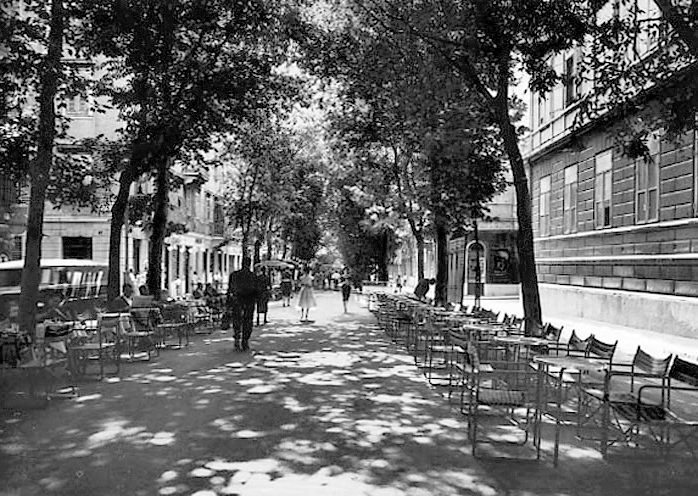
Also called Aquedoto, because of the acqueduct from the time of Maria Theresa that orginally flowed beneath this treelined mall. Here we find the Politeama Rossetti (1878) where Martin Kačur-Biography of an Idealist, Tomizza’s dramatic adaptation of the Slovene writer, Ivan Cankar’s novel of the same name, was produced. The Viale is intersected by via Rossetti, where the young couple of The Newlyweds in via Rossetti live.
After spending the night together, they considered themselves to be secretly plighted to each other. He would wait for her in via dell’Acquedotto, at the bottom of the steep rise in via Rossetti. … They would walk together slowly under the chestnuts of the viale, the outdoor tables of bars and cafes on either side…
– The Newlyweds in via Rossetti, p.50
3. Synagogue
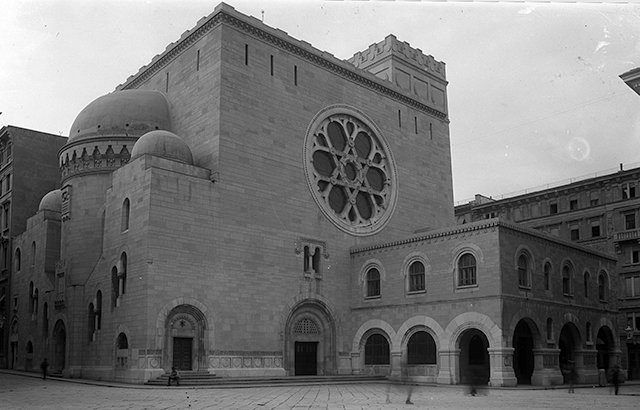
Via S. Francesco, 19
One of Europe’s largest synagogues, it was designed by the architects Arduino and Ruggero Berlam (1912) and survived the Nazi occupation during WWII. This became an important location for Fulvio Tomizza after his marriage to a Jewish woman introduced him into Trieste’s Jewish community.
The only thing I knew about the Jewish Temple was that you couldn’t enter without covering your head; and from those who went there that they were hated by the Germans.
… At sunset, a girl came out of the Synagogue whose eyes as she came down the steps gave me such a penetrating look that all I could do is manage a frozen half smile in reply… rousing myself, I began following her down the narrow street…
– Tree of Dreams, p.116, p.127
4. Prison
Via Coroneo, 26
The name via Coroneo derives from the 17th century Bishop of Ljubljana, Tomaž Hren, who had a large estate in this area of Trieste. This is where Stanko Vuk, the husband of Danica Tomažič in the novel The Newlyweds in via Rossetti, is incarcerated.
Towards the end of October… an official of the Carabinieri knocked on the door, demanding entrance. Once inside, he declared Vuk Stanislao under arrest for “anti-patriotic activities” and ordered the agents to handcuff him.
– The Newlyweds in via Rossetti, p.80
5. Courthouse
Via Foro Ulpiano, 1
Completed in 1934, it is the centrepiece of the monumental urban planning in this area of the city. This is where Stanko Vuk is interrogated.
… That Vuk Stanislao was the leader of the Christian-socialists in the province of Trieste… and concealed his political activity by performing unspecified tasks for don Milanović’s cultural and publishing firm, for which…. he also distributed books and propaganda materials… That he was married to Danica Tomasi, sister of the communist leader Giuseppe Tomasi…
– The Newlyweds in via Rossetti, p.85-86
6. Piazza Oberdan
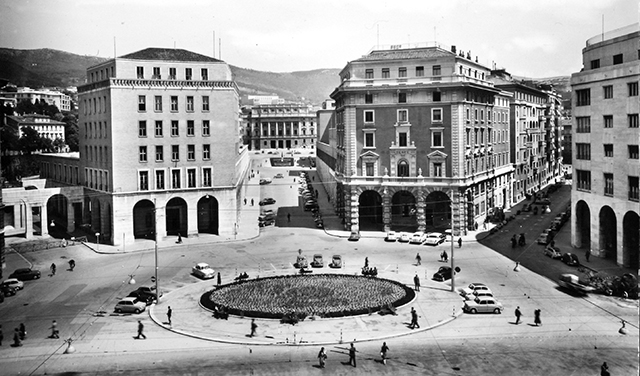
The first piazza to be planned after Trieste became part of Italy, it was projected by Umberto Nordio on the site of the Austrian barracks. Behind the Regional Building are the studios of the RAI, where Tomizza worked for 20 years as a journalist. Under the portico of the RAS Building, a plaque recalls that this was the headquarters of the SS during the Nazi occupation. On the corner stood the Adriaco Caffè, where Tomizza liked to meet with other intellectuals and artists. Among them was Marcello Mascherini whose sculpture “The Song of Songs” (1990), is at the centre of the piazza. Nearby was one of Trieste’s most famous cafes, the Caffè Fabris.
It was a pleasure for Stanko to no longer have to go to the local cafes alone, cafes like the Specchi, Fabris and the Stella Polare, where he had spent so much of his first stay in Trieste reading and scribbling poetry, just like in the cafes of Ljubljana and Venice
– The Newlyweds in via Rossetti, p.70
7. Narodni dom
Via Filzi, 14
 Today the site of the Upper School of Modern Languages for Interpreters and Translators, the Narodni Dom, or House of the Nation, was designed by Max Fabiani (1904) and was home to the economic-financial institutes and the athletic and cultural associations of the Slovene, Croat and other Slav populations present in Trieste before WWI. It was completely destroyed in a fire set by Fascist squadrons in 1920, and rebuilt after WWII. Like Franziska, the protagonist of Tomizza’s novel of the same name, Max Fabiani was also from the Carso.
Today the site of the Upper School of Modern Languages for Interpreters and Translators, the Narodni Dom, or House of the Nation, was designed by Max Fabiani (1904) and was home to the economic-financial institutes and the athletic and cultural associations of the Slovene, Croat and other Slav populations present in Trieste before WWI. It was completely destroyed in a fire set by Fascist squadrons in 1920, and rebuilt after WWII. Like Franziska, the protagonist of Tomizza’s novel of the same name, Max Fabiani was also from the Carso.
He climbed all the stairs of the Narodni Dom, passing the Balkan Hotel and a cafe, a bank and the offices of various musical and theatrical groups, athletic and sports associations, school administrations, etc.; until he finally found himself before the door of the office he was looking for, which was located on the topfloor, right under the roof.
– Franziska, p.86
8. Railway Station
Piazza della Libertà, 8
The Railway Station was built in 1878, as the southern terminus of the Trieste-Vienna-Prague line. The piazza in front of the Station, the nearby port facilities and the imposing palazzi of merchants, shipbuilders and entrepreneurs of the most diverse origins, testify to the rapid economic growth of the city. Facing onto the piazza and in the immediate vicinity we find the palazzi of the Slovene Kallister family, the Panfili of Rovigno, the Economo of Salonika, the Parisi from Trento, and the Catolla family from Switzerland. The convoys of Triestine Jews bound for the Nazi deathcamps during WWII left from here. Next to the Station are the so-called Silos. Originally designed for the storage of commodities and other goods, in the postwar period it became a collection centre for refugees from Istria, a theme which is central to Tomizza’s work. Franziska and her family lived in the nearby viale Miramare, after they had moved to Trieste from the Carso during WWI.
The Skripac family found a flat in viale Miramare, in front of the Railway Station. Dušan began work as a day-labourer in a sawmill run by Slovenes in the area of Gretta.
– Franziska, p.80
9. Lutheran Evangelical Church
Largo Panfili
Built in 1878 by the Lutheran Community of Trieste, it is one of many non-Catholic churches and places of worship in the city. The Reformation movement, which had considerable impact on Trieste and nearby Istria in the 16th and 17th centuries, provides the backdrop to Tomizza’s novel, Evil Comes from the North. The narrative revolves around the relations between the Bishop of Capodistria, Pier Paolo Vergerio, his counterpart in Trieste, Pietro Bonomo, and the Slovene pastor, Primož Trubar, an important exponent of the Reformation in Slovenia.
It was to this region where faith and learning went hand in hand, that the Slovene exile Primus Trubar, pastor in the neighbouring Bavarian city of Kempten (but under the Empire) had come… while residing in Tübingen he had already offered his people the very first book printed in their mother tongue, a Catechism.
– Evil Comes from the North, p. 374
10. The Canal: Palazzo Gopcevich
Via Rossini, 4
Built in 1850 for a wealthy Illyrian family, today it is a cultural and exhibition centre for the City of Trieste. From the end of the Canal, Franziska sees the Italian troops arrive in 1918, and realises that the Austro-Hungarian melting pot of many diverse peoples and ethnic groups is about to end.
After the Canal, it became impossible to walk and you could only move forward by dint of shoving and pushing, and without being able to see where your feet were. It was difficult for a frank and sentimental person like herself to resist sharing, not just such happiness, but an enthusiasm which seemed to be unanimous, totalising. She regretted not being able to share in this emotion…
– Franziska, p. 93
11. Piazza Ponterosso
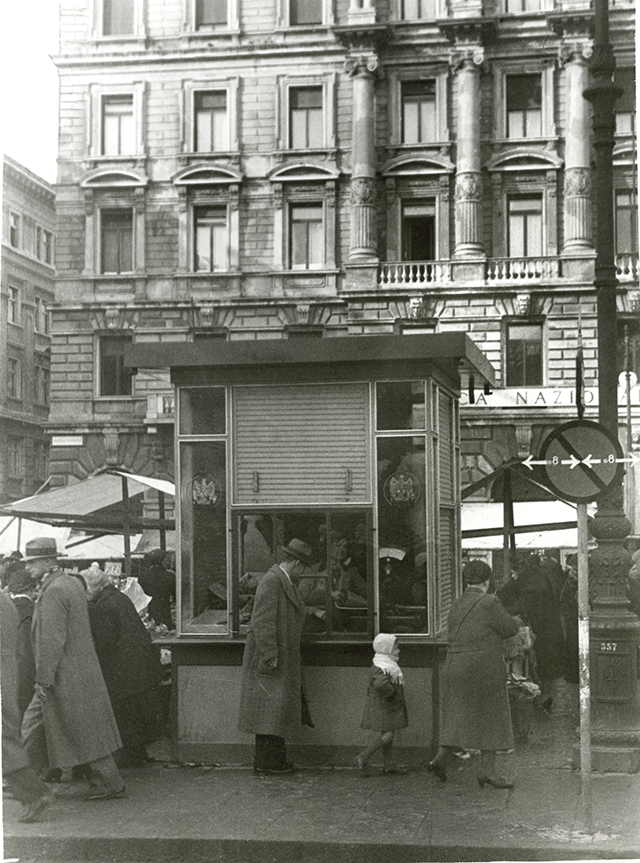
This was the first piazza in the new city being built by Maria Theresa, and it appears often in Tomizza’s Triestine novels. It is here, for example, that Mr. Cohen, Miriam’s father, has his storehouse, and where the protagonist also lives.
… Mr. Cohen, who went each day to a mysterious office at the storehouse in Ponterosso, and which the family referred to as the “bottega” […] shortly after, I found a flat nearby…
– Miriam’s City, p.23, p. 40-41
12. Church of St. Anthony the Miracleworker
Via Ponchielli, 2
Built in Neo-classical style by Pietro Nobile (1842), this is the only Catholic Church in Borgo Teresiano. It is an important location for both Tomizza and Stanko Vuk.
At 6 o’clock I went to St. Anthony’s […] I was the same little crawthumper as before, but with such a change in my spirit and attitude […]
– Tree of Dreams, pp.135-136After taking a job with a cultural consortium that owned a small shop selling religious articles and books in via Paganini, on the sunless side of the Church of St. Anthony the Miracleworker…
– The Newlyweds in via Rossetti, p.39
13. Pepi’s Buffet
Via Cassa di Risparmio, 3
“Pepi’s Buffet” – aka “Pepi s’ciavo” – dates from the turn of the last century. The owner was the father of Danica Tomažič, protagonist of The Newlyweds of via Rossetti. The novel reconstructs a series of historical events that actually occurred in Trieste.
Her […] father was known to everyone as the owner of “Pepi s’ciavo”, the city’s most famous buffet and where we all had eaten at least once.
– The Newlyweds in via Rossetti, pp.37-38
14. Piazza Unità and Audace Pier
The largest seafronting square in Europe, piazza dell’Unità is the city’s showpiece. Fulvio Tomizza would pass through here on his daily walk to the Public Library. The Pier is named after the first Italian warship that docked in Trieste in November 1918, claiming the city for Italy. This is where Franziska, just arrived from her small village on the Carso, sees the sea for the first time.
She saw the sea for the first time and was spellbound, shaken to her core, felt almost a sense of humiliation. […] The horizon, which when seen from the quays, seemed to blend with the sky, had a precise significance, for beyond it lay Italy…
– Franziska, pp.73-74
15. Basilica of St. Sylvester and St. Mary’s Church
Piazzetta San Silvestro and via del Collegio, 6
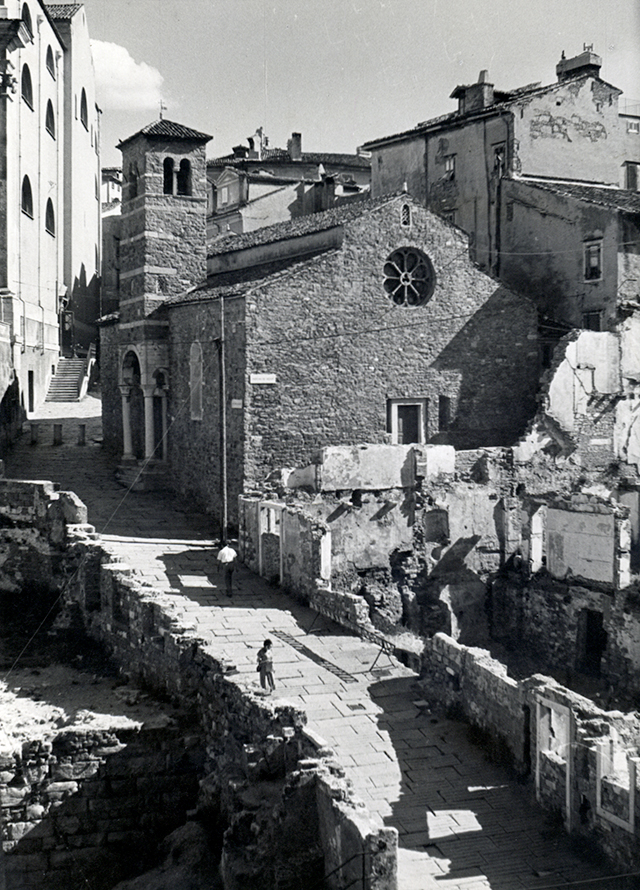
The Basilica of St. Sylvester (XI sec.), one of the rare examples of the Romanic style in Trieste, has been a Helvetian church since 1784. Next to it stands St. Mary’s Church (also known as the Jesuit Church), which is Trieste’s only baroque church. During WWII, the adjacent college was used as a women’s prison. Danica Tomažič was incarcerated here.
They joined her there and together with her friend accompanied her first to the local jail, then to the one in Fiume, and then a few days later, to the women’s prison in Trieste, known as the Prison of the Jesuits.
– The Newlyweds in via Rossetti, p.80
16. St. Justin’s Cathedral
Piazza della Cattedrale, 2
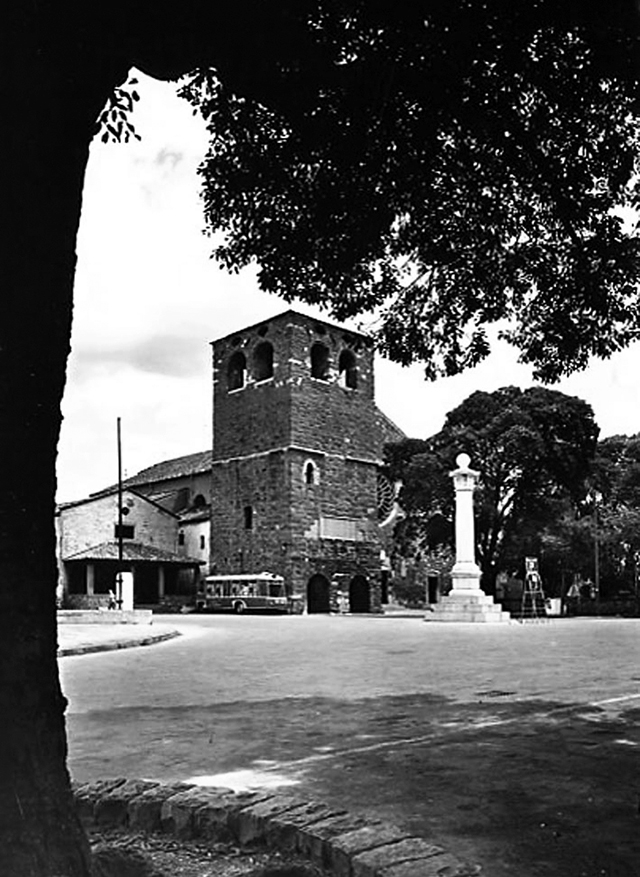
Consecrated is 1304, the Cathedral was formed by the fusion of two smaller, pre-existing structures. Among the busts on the facade is that of Enea Silvio Piccolomini, later Pope Pius II. This is where Bishop Pietro Bonomo ordains Primož Trubar and where Tomizza was married.
The itinerary is based on “La Trieste di Tomizza. Itinerari”, by Patrizia Vascotto and Stella Rasman, Comunicarte Edizioni, Trieste 2013
